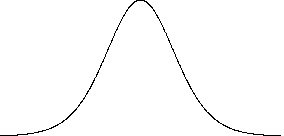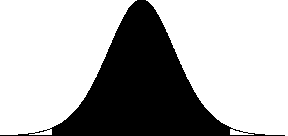24-1: Parameters vs. Statistics ( cont. )
(a) statistic; ![]()
(b) parameter; µ
(c) statistic; s
(d) parameter; ![]()
(e) parameter; µ
(f) statistic; ![]()
(g) parameter; µ
(h) statistic; s
(i) parameter; µ
(j) parameter; µ
(k) statistic; ![]()
24-2: Students' Sleeping Times
(a)
|
Hypothetical sample |
Sample size |
Sample mean |
Sample standard deviation |
|
1 |
10 |
7.60 |
.825 |
|
2 |
10 |
7.60 |
1.597 |
|
3 |
30 |
7.60 |
.825 |
|
4 |
30 |
7.60 |
1.599 |
(b) same mean
(c) variability
(d) 1
(e) 1
(f) sample size
(g) 3
(h) 3
(i) 3
(j) 2
(k) sample mean, sample standard deviation, sample size
24-3: Exploring the t -Distribution
(a)

(b)

(c) .025
(d) 2.201
(e) greater
(f) 2.069
(g) 2.704
(h) 1.990
24-4: Exploring the t -Distribution ( cont. )
(a) .1
(b) .025
(c) between .025 and .01
(d) between .025 and .01
(e) between .005 and .001
(f) less than .005
(g) greater than .2
(h) between .010 and .002
24-5: Students' Sleeping Times ( cont. )
(a) - (c)
|
Hypothetical sample |
Sample size |
Sample mean |
Sample std. dev. |
95% confidence intervaL |
(One-sided) p-value |
|
1 |
10 |
7.6 |
0.825 |
7.010, 8.190 |
.080 |
|
2 |
10 |
7.6 |
1.597 |
6.457, 8.743 |
.22 |
|
3 |
30 |
7.6 |
0.825 |
7.292, 7.908 |
.0063 |
|
4 |
30 |
7.6 |
1.599 |
7.003, 8.197 |
.091 |
(d) Most accurate: 3;
Least accurate: 2;
Most evidence: 3;
Least evidence: 2
24-6: Students' Sleeping Times ( cont. )
(a) - (d) Answers vary.
(e) The confidence interval would be narrower and the p-value smaller.
(f) The confidence interval would be wider and the p-value larger.
(g) The confidence interval would have the same width but be shifted down; the p-value would be smaller.
(h) Answers vary.
(i) No, since the fact that the students got up for an 8:00 am class would affect the amount of sleep they got.
![]()
25-1: Students' Travels ( cont. )
(a) - (c) These answers depend on class results
(d) Part of this answer depends on class results. No, this proportion should not be close to 90% because the interval estimates the mean number of states visited in the population and not individuals' values.
(e) cut in half
(f) decrease to one-third its original size
(g) not technically a simple random sample, but probably fairly representative
(h) The answer depends on class results.
25-2: Hypothetical ATM Withdrawals ( cont. )
(a)
|
Sample size |
Sample mean |
Sample std. dev. |
95% confidence interval |
|
|
Machine 1 |
50 |
70.0 |
30.30 |
(61.39, 78.61) |
|
Machine 2 |
50 |
70.0 |
30.30 |
(61.39, 78.61) |
|
Machine 3 |
50 |
70.0 |
30.30 |
(61.39, 78.61) |
(b) No, the distributions are very different.
(a)
|
Couple # |
Husband |
Wife |
Difference (husband - wife) |
|
1 |
25 |
22 |
3 |
|
2 |
25 |
32 |
-7 |
|
3 |
51 |
50 |
1 |
|
4 |
25 |
25 |
0 |
|
5 |
38 |
33 |
5 |
|
6 |
30 |
27 |
3 |
|
7 |
60 |
45 |
15 |
|
8 |
54 |
47 |
7 |
|
9 |
31 |
30 |
1 |
|
10 |
54 |
44 |
10 |
|
11 |
23 |
23 |
0 |
|
12 |
34 |
39 |
-5 |
|
13 |
25 |
24 |
1 |
|
14 |
23 |
22 |
1 |
|
15 |
19 |
16 |
3 |
|
16 |
71 |
73 |
-2 |
|
17 |
26 |
27 |
-1 |
|
18 |
31 |
36 |
-5 |
|
19 |
26 |
24 |
2 |
|
20 |
62 |
60 |
2 |
|
21 |
29 |
26 |
3 |
|
22 |
31 |
23 |
8 |
|
23 |
29 |
28 |
1 |
|
24 |
35 |
36 |
-1 |
(b) ![]()
(c) ![]() = 1.875; s = 4.812
= 1.875; s = 4.812
(d) ![]() :
: ![]() = 0
= 0
![]() :
: ![]() > 0
> 0
t = 1.91
p-value = .034
(e) (.191, 3.559)
(f) (Asks for interpretation)
25-4: Planetary Measurements ( cont. )
(a) (71.22, 2132.78)
(b) No, the interval is senseless since the data do not constitute a sample from a population.
![]()
26-1: Hypothetical Commuting Times
(a) no
(b) Yes, route 1 seems to be quicker.
(c)
|
Sample Size |
Sample mean |
Sample standard deviation |
|
|
Alex 1 |
10 |
28 |
6 |
|
Alex 2 |
10 |
32 |
6 |
(d)
|
Sample Size |
Sample mean |
Sample standard deviation |
Two-sided p-value |
|
|
Alex 1 |
10 |
28 |
6 |
.15 |
|
Alex 2 |
10 |
32 |
6 |
(e) no; no; the observed difference in times is not unlikely to have occured by chance.
(f) Barb's centers are farther apart.
(g) Carl's times are less spread out.
(h) Donna has larger samples of times.
(i)
|
Sample Size |
Sample mean |
Sample standard deviation |
Two-sided p-value |
|
|
Barb 1 |
10 |
25 |
6 |
.0017 |
|
Barb 2 |
10 |
35 |
6 |
|
|
Carl 1 |
10 |
28 |
3 |
.0080 |
|
Carl 2 |
10 |
32 |
3 |
|
|
Donna 1 |
40 |
28 |
6 |
.0038 |
|
Donna 2 |
40 |
32 |
6 |
(j) Barb's sample means are farther apart;
Carl's sample times are less variable (smaller standard deviation);
Donna has larger samples of times.
26-2: Students' Haircut Prices
(a) - (e) These answers depend on class results.
26-3: Trading for Run Production
(a) raw data (at least sample sizes and standard deviation)
(b)
|
Minimum |
Lower quartile |
Median |
Upper quartile |
Maximum |
|
|
Without McGriff |
0 |
2 |
3 |
5 |
13 |
|
With McGriff |
0 |
3 |
5 |
8 |
18 |
(c)
|
Sample size |
Sample mean |
Sample standard deviation |
|
|
Without McGriff |
94 |
3.989 |
3.074 |
|
With McGriff |
68 |
5.779 |
3.816 |
(d) t = -3.19; p-value = .0018
(e) no
(f) no; this is an observational study